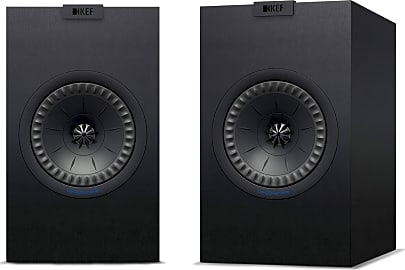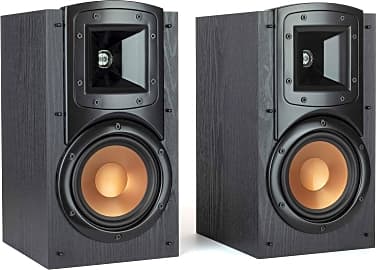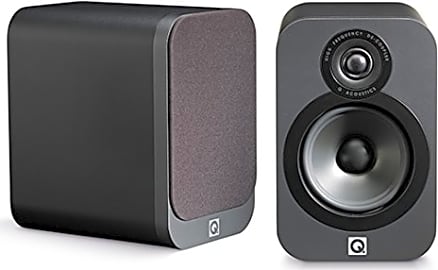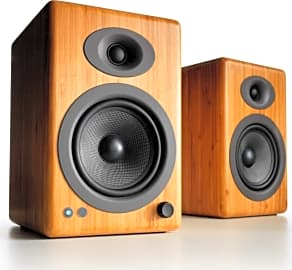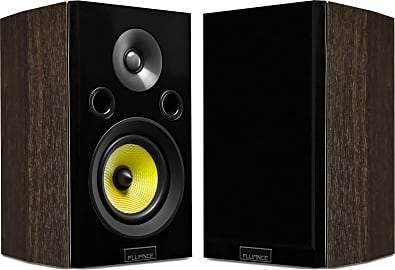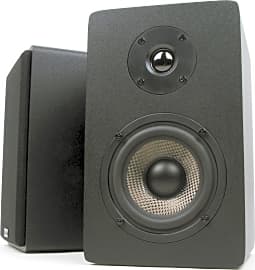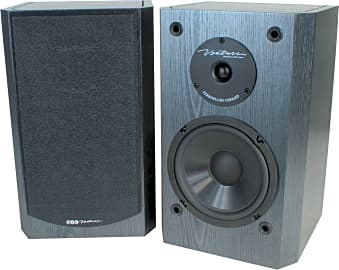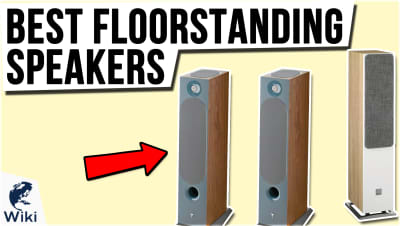The 10 Best Bookshelf Speakers

This wiki has been updated 37 times since it was first published in December of 2015. Offering powerful sound in a relatively compact size, these bookshelf speakers will deliver a faithful reproduction of your favorite audio tracks without looming large in your home office, den or living room. They generally respond as low as 40 hertz, which makes music sound great, and they come in self-powered as well as passive configurations, so you don't necessarily need a standalone receiver. When users buy our independently chosen editorial choices, we may earn commissions to help fund the Wiki.
Editor's Notes
December 16, 2020:
With our latest update, we added a good number of products to the list. The KEF Q350 was swapped in for the Pioneer Andrew Jones BS22, which is no longer available, and it sports a unique design that places the HF driver in the center of the midrange cone. The array is positioned at the center of the cabinet with the aim of minimizing internal resonance and providing the listener with only the sounds they want to hear. It doesn't have the best bass response, so it's a good choice for those who have a complete home theater system.
Similarly, the Fluance Signature HiFi provides crisp, clear high frequency and mid-range audio but lacks a bit of power in the bass department. It's best when integrated into a full home theater system.
We updated the Audioengine A5+ to the company's latest version, which now supports Bluetooth with the Qualcomm aptX HD codec. It has a built-in 24-bit DAC, which converts the digital signal to analog before it's sent to the class-AB amplifiers. This is one of the better choices for music and it provides a classic analog sound, even with the use of Bluetooth.
We also updated the Klipsch R-15M to the Klipsch Synergy B-200, the Elac B6.2 Debut Series to the Elac Uni-Fi UB52, and the Edifier R1280T Powered to the Edifier R1280DBs, all of which are the companys' latest versions. For the most part, their designs remain very similar.
November 15, 2019:
There's a massive variety of bookshelf loudspeakers to choose from out there, so no matter your budget there's something for you -- in fact, the vast selection available can be a little intimidating. There's no need to worry if you're on a tight budget; even if you can't afford a great amplifier, you'll be all set with the Edifier R1280T Powered. They're extremely well-engineered for an affordable pair and their dual inputs make them especially versatile. If you already have a good amp, the Micca MB42X are tough to beat, and make great left and right channels for mid-range surround sound systems. The BIC America DV62si and Pioneer Andrew Jones BS22 are also great budget-friendly choices.
If you're willing to make a bit more of an investment, you do of course have a bunch more options. The Fluance XL7S High Performance and Klipsch R-15M are priced in the middle of the pack and will perform very well, but for a little more you can step up to some high-end models such as the Q Acoustics 3020 and Polk Audio Signature S15. The former are often talked about by audiophiles and have large drivers that put out especially clear and distortion-free sound, while the latter are built with high-end components from the cones to the binding posts.
If you have no objections to their high cost, though, few will argue that the Audioengine A5+ and Elac B6.2 Debut Series are among the best of the bunch. Gold-plated connectors, long-term reliability, and exceptional maximum volumes make them great choices for the most discerning listeners.
Special Honors
JBL L100 Classic They're a touch larger than most bookshelf speakers, but their reputation and price tag blow away pretty much all the others. They respond from 40 to 40,000 hertz using a three-way system including 12- and 5-inch woofers and a 1-inch titanium tweeter. If you have plenty of money to burn and want the best, these are absolutely worth a look. jblsynthesis.com
Klipsch Reference Premier This isn't the absolute most expensive line of equipment, but nonetheless, you should only look to these if you're a notable stickler for accurate reproduction. Actually, we'd recommend looking into the floor-standing towers as well as the bookshelf variants, and whichever you choose, you'll definitely want to pair them with a high-end receiver. klipsch.com
Q Acoustics Concept 300 These bad boys may be the ultimate upgrade for listeners who demand the highest quality from both digital and analog sources. Their retro-futuristic appearance, ultra-high-quality construction, and top-of-the-line components mean they should provide loud and accurate audio for many years to come. qacoustics.com
Can You Hear Anything, Now?
Imagine you have a nightclub teeming with crazy patrons, each of whom represents a frequency range within a music file.
It seems that, for the most part, the desire to maximize the quality of one’s audio experience has all but disappeared from the populace. In many instances, especially among younger music fans, an effort to reach a baseline audio quality isn’t even there.
The music we experience today is predominantly digitized, compressed beyond oblivion to minimize the amount of space it takes up on a hard disk, or the amount of cellular data it consumes while you stream it. That results in far less space in which a music file has to breathe.
Imagine you have a nightclub teeming with crazy patrons, each of whom represents a frequency range within a music file. Then the fire marshal–let’s call him Marshal John Capital Ruthlessness–comes along, and he says the club is beyond capacity. So, he forces you to kick out some of the patrons. You start with the lowest and highest frequency ranges because they’re the least utilized by the bulk of musicians.
A week goes by, and everything seems normal again. Then, Marshal Ruthlessness shows up again and forces you to sacrifice another handful of ranges. This pattern continues until you finally have the average 192 kbps bitrate you find across the streaming industry, a bitrate that leaves a lot of sound on the cutting room floor.
The problem gets even worse when you pump that low-quality music through computer speakers or cheap ear bud headphones. In a sound environment like this, we need quality headphones or quality speakers like never before. The bookshelf speakers on our list offer a relatively inconspicuous means by which you can take even the poorest quality audio stream and project a clear and nuanced sound into your space.
Cone Heads
The mechanisms of any speaker system are essentially the same, though the quality of certain ingredients, rather as in cooking, can make a big difference in the tasty tones they produce. You’ll usually encounter two to three cones for audio output on an individual speaker.
The first two, that are present almost ubiquitously, are the woofer and the tweeter. Traditionally, the tweeter handles the highest frequencies in the range, and the woofer handles the lowest. In a set of bookshelf speakers, however, both of of the cones creep a little more toward the middle than they would if they were incorporated into a more elaborate system.
You’ll usually encounter two to three cones for audio output on an individual speaker.
Occasionally, a set of bookshelf speakers will include a third means of audio output, often appearing as a hardened channel through which you can feel air passing. This third opening is sometimes a small, circular hole between the other cones, and other times it's a thin slot toward the bottom of the cabinet. These are bass reflex ports that pump out a little extra low end in support of that centrist woofer.
These are all important mechanisms to consider in your purchase, but you’ll also want to look at things like whether the speakers are active or passive. If you already have a good receiver set up in your home, or you’re planning to get one, a pair of passive speakers would be best. That way, you know that every bit you spend on them goes into their housing and their sound quality, without extra circuitry taking up space and design.
With a set of active speakers, on the other hand, you can grab an RCA to 3.5mm cable and plug your cell phone right into the back of the unit, unless you have a newer iPhone, of course. That could save you valuable space if you’re tight on room, but the preamps in these are usually pretty middling in quality.
The last thing worth considering, especially if you’re down to two or three options the specs of which all seem like they compete pretty well with one another, is style. These aren’t the biggest speakers on the market, so they aren’t intended to be the centerpiece of any space, but when they’ve got music coming out of them, it’s a simple thing for anyone in your home to trace those vibrations back to their source. This comes down to a matter of taste, so don’t be ashamed to choose a speaker with good specs just because it’s pretty.
Vibrations In A Cave
Early man spent a lot of time in caves. Evidence of fires, meals, and artworks left behind on the walls of those caves all indicate that man was a dweller of enclosures long before he figured out how to build them for himself. Back in those cave, it had to be apparent to those early humans that their voices sounded different inside the cave than they did without. There was an echo, and a kind of amplification, as the vibrations of their voices bounded around off of the rock walls.
Even today, if you sit in the top row, you can hear two people talking on those stages.
They wouldn’t have had the science or the language to communicate this experience abstractly, but these had to have been the earliest kernels of individual understanding that sound could be changed by its environment.
Later, when the ancient Greeks built their amphitheaters, they constructed them in such a way that the voices of the actors carried upward and in the direction of the audience. Even today, if you sit in the top row, you can hear two people talking on those stages.
To help those voices of antiquity reach the back row over a rowdy crowd, however, the actors wore masks that included crude analogue megaphones in their mouths, amplifying the sounds of their words.
Once Edison came along with his phonograph, amplification was off and running toward ever-improving developments. The phonograph used a horn speaker, closer in relationship to the amplifiers in those Greek masks. It wasn’t until the early 20th century that a handful of audio engineers developed the technology that would combine to form the electrodynamic loudspeaker, the magnetic device we see in all of these bookshelf speakers and in almost every speaker system around the world.




